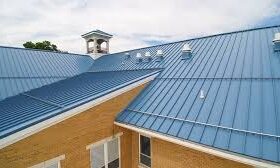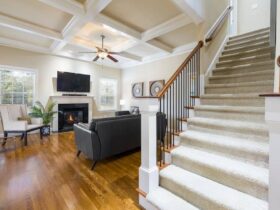If you’re house-shopping, you may have a very specific look or aesthetic in mind. The benefit of learning the name of the home architectural styles is quick, concise communication with your real estate agent. Even if that exact style isn’t available in your price range or residential area of choice, they will still have an idea of what you like and will be able to show you options based on that, allowing you to quickly find the home of your dreams.
Adamesque
Developed by the Adam family of architects in the 18th century, Adamesque buildings are influenced heavily by Roman ruins and similarly can feature columns or pilasters. The interior design draws influence from earlier rococo and baroque art eras in terms of color and motifs. This style also features highly elaborate plaster molding and arching doorways and precedes the similar Greek and Roman Revivals.
American Colonial
American colonial architecture is an umbrella term for a variety of styles from different countries that were built when Europeans were first settling in the United States. Here are two rather popular colonial styles:
Dutch colonials sometimes have bisected Dutch doors (or stable doors) and steeply pitched roofs. Dutch-Anglo hybrids have gambrel roofs with eaves that point out rather than down. They are typically built with stone for a very cobbled appearance.
Georgian colonials are English in origin and are named after English kings George II and George III. They tend to be spartan brick structures with wooden accents and very little flourish. They are commonly described as “box-like” as they are very symmetrical and rectangular.
Other American colonial styles are French, German, Spanish, and Mid-Atlantic.
Italianate
When people say “Victorian” they tend to be talking about Italianate styles; this is because the classification of Victorian refers more to an era than an aesthetic.
While inspired by Italian architecture, this particular style is a British invention. Italianate houses can have either flat or ungabled hip-roofs. While they can be “box-like”, their resemblance to Georgian colonials stops there, as there is a lot of highly decorative molding, gabled windows, and sometimes even cupolas (a decorative topper).
Modern
In this context modern doesn’t mean “the present” but “modernism”, an art movement that was focused on abstraction, invention, and minimalism. It actively rejected realism and functionless embellishment. In modernist architecture, nothing is included unless it serves a functional purpose. Glass and steel feature heavily here, and structures tend to be either geometric or streamlined. Modern structures can be quite beautiful despite their simplicity, especially when juxtaposed with a natural setting, making them some of the most luxurious homes in Ohio and elsewhere.
Tudor
This is a style that can have a lot of variety—even in a single building. The roofs can be very steep, as are the front-facing gables. Tudor houses are usually brick or stone buildings, but sometimes when people say Tudor they mean a building with half-timbering on the facade. Sometimes people mix both styles, using the half-timbering as an accent for gables, or contrasting levels by using a different style for each.
Schedule a viewing with your real estate agent today to see these stunning home architectural styles in person!















